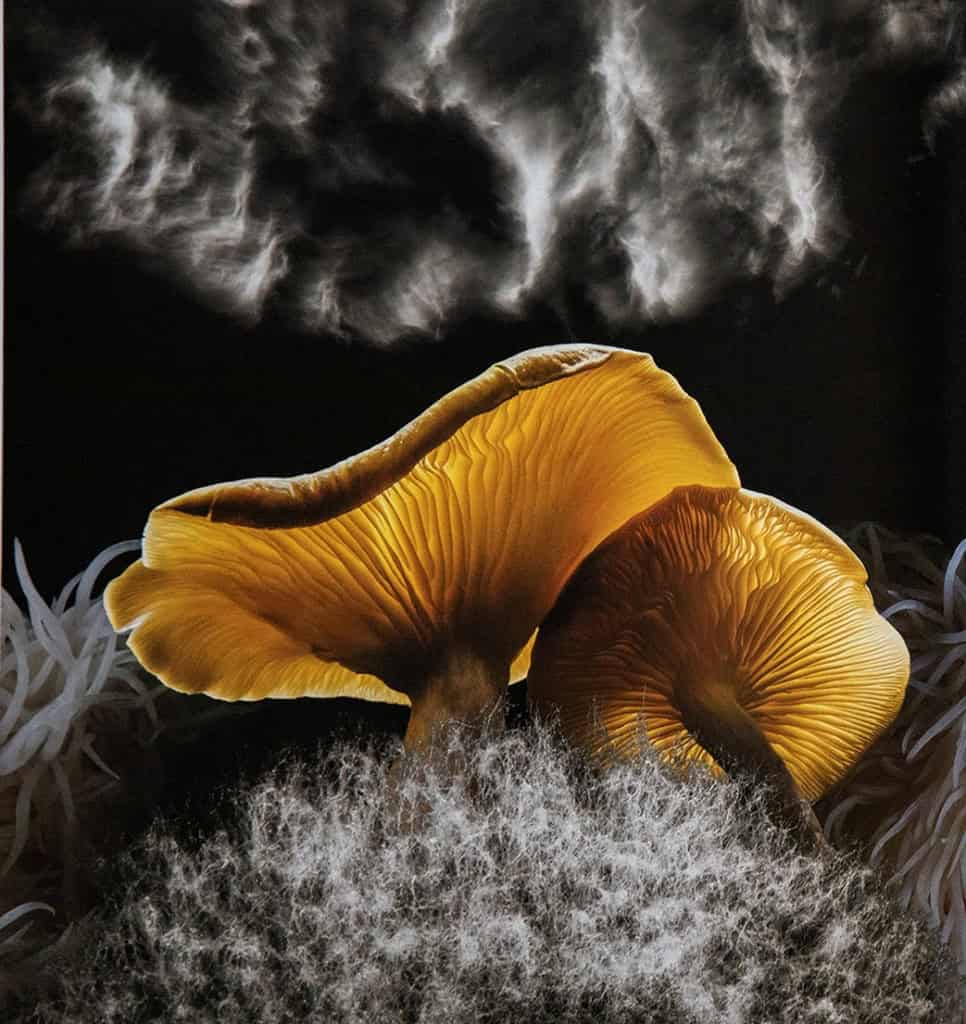
Food Planet Future
When I sit down to eat a meal, I want to know that the food on my plate hasn’t been grown at the expense of the planet. It’s ironic that the mere act of feeding ourselves every day tethers us to agricultural systems that wreak chaos on ecosystems and the climate. But there are ways to grow food that regenerate the Earth. These immense, portentous stories must be told, and I’m inspired to do so through art, by zooming in to the tiniest views of food that I can imagine. Awe and wonder feed the human spirit. They are the nourishment we need to help us face ecological breakdown, and to work to reverse it.
I employ photomontage to blend scanning electron microscope (SEM) micrographs of pollen, seeds, leaves, and other elements with macro photographs, creating a surreal conversation between a food or other object, and microscopic parts of itself.

RICE
Over one billion people depend on rice cultivation for their economic and cultural sustenance. The importance of rice makes any threats to rice yields—such as reduced nutrient content and salt damage—a humanitarian concern.
Remarkably, perennial rice, the outcome of years of international research collaboration, is now being grown in south China and Uganda. Tens of thousands of smallholder farms can obtain the same yields with this rice and enjoy eight harvests compared to a single harvest with annual varieties, while saving on costly labor, fertilizer, and seed supplies. This rice may eventually be grown on nearly three billion acres.
MACRO: Rice husks, Oryza sativa sub japonica, embryonic rice (green)
MICRO: Rice anthers, pollen, awn: 340x

AZOLLA, FLOATING FERN
50 million years ago, Azolla grew in such huge quantities near today’s Arctic region that it is credited with removing half of the excess carbon dioxide from the atmosphere. Azolla produces lipids, making it a potential source of biofuels. Because it is a water-based plant, it doesn’t compete with other crops for scarce arable land. It offers an inexpensive source of easily digested animal feed, giving small farmers an alternative to expensive grains. This fast-growing, high-protein plant is being used for livestock feed, fertilizer, and possibly, for human consumption.
MACRO: Azolla, Azolla filiculoides; floating fern
MICRO: Fern leaf detail: 130x

MUSHROOM
It’s hard to overstate the importance of fungal/mycelial networks for creating healthy soil, optimum conditions for plant growth, and remarkably, rain. Acting like an internet of the soil, the mycelium fungus transports micronutrients to plants through branching filaments. In exchange, this fungal “mat” is fed with sugars produced by plants during photosynthesis. It binds soil and breaks down dead plants and animals. This allows soil to hold more water—a blessing that is too often shattered by annual tillage of land for new crops. Trillions of fungal spores released into the air act as rain seeds, helping to create clouds. New research finds as much as a third of annual global carbon emissions may be taken up by underground fungi, making soil conservation and regeneration all the more consequential.
MACRO: Wine cap mycelium, Stropharia rugosoannulata, lion’s mane, Hericium erinaceus, golden oyster, Pleurotus citrinopileatus, cloud

POTATO
Climate chaos has come to the Andes, the ancestral home of potatoes. Droughts and floods, warming temperatures, pests, and diseases are creating stress on the crops. Multigenerational potato guardians store potato diversity in the ground and harvest it, sometimes several times a year. An intimate connection to soil, altitude, water, climate, and pests allows them to witness changes up close, potentially deriving new successful cultivars.
MACRO: Potatoes, Solanum tuberosum
MICRO: Potato starch granules, 1,000x
Food Planet Future takes the reader on a remarkable visual tour of everyday foods and in the process, connects us more deeply to the world we help to shape. It draws upon art, research, and innovative practices to reimagine the tangled crises of food security, climate change, and biodiversity loss. Food Planet Future invokes awe and wonder and inspires action taken on our Earth’s behalf.
A career science educator and self-taught photographer, Robert Dash searches out tiny subjects with large stories about climate, conservation, and biodiversity. His work has been published by TIME, Geographical, Lenswork, and National Geographic. His traveling exhibition, which birthed this book, is titled Food Planet Future and runs through January 2025 at Beaty Biodiversity Museum in Vancouver, Canada.

